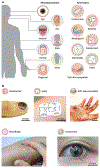Translational gaps and opportunities for medical wearables in digital health
- PMID: 36223451
- PMCID: PMC10193448
- DOI: 10.1126/scitranslmed.abn6036
Translational gaps and opportunities for medical wearables in digital health
Abstract
A confluence of advances in biosensor technologies, enhancements in health care delivery mechanisms, and improvements in machine learning, together with an increased awareness of remote patient monitoring, has accelerated the impact of digital health across nearly every medical discipline. Medical grade wearables-noninvasive, on-body sensors operating with clinical accuracy-will play an increasingly central role in medicine by providing continuous, cost-effective measurement and interpretation of physiological data relevant to patient status and disease trajectory, both inside and outside of established health care settings. Here, we review current digital health technologies and highlight critical gaps to clinical translation and adoption.
Conflict of interest statement
Figures


References
-
- Bestsennyy O, Gilbert G, Harris A, Rost J, “Telehealth: A quarter-trillion-dollar post-COVID-19 reality?” (McKinsey and Company, 2021).
-
- Ray TR, Choi J, Bandodkar AJ, Krishnan S, Gutruf P, Tian L, Ghaffari R, Rogers JA, Bio-integrated wearable systems: A comprehensive review. Chem. Rev 119, 5461–5533 (2019). - PubMed
Publication types
MeSH terms
Grants and funding
LinkOut - more resources
Full Text Sources
Medical

